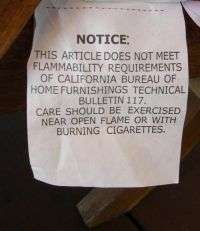Potentially toxic flame retardants highest in California households

In what may be an unintended consequence of efforts to make furniture safer and less flammable, residents of California have blood levels of potentially toxic flame retardants called PBDEs at levels nearly twice the national average, scientists from Massachusetts and California are reporting. Their study, the first to examine regional variations in PBDE levels in household dust and blood within the U.S., is scheduled for posting online Oct. 1 by ACS' journal Environmental Science & Technology.
In the new study, Ami Zota and colleagues note that PBDEs (polybrominated diphenyl ethers) are widely used as flame retardants in upholstered furniture and electronics.
The materials are released into the environment as dust particles, where they can accumulate in homes as well as human blood and tissue. Although their exact effects in humans are unclear, studies in animals suggest that PBDEs may cause thyroid, developmental, and reproductive problems. Since California has among the most stringent furniture flammability standards, the researchers suspected that state residents may have higher levels of PBDE dust exposure than others in the United States.
To find out, the scientists compared data on PBDE concentrations in house dust from 49 California homes with concentrations reported from 120 Massachusetts homes and several other areas. The researchers also compared data on blood levels of PBDEs in California residents to blood levels in residents of other regions. They found that PBDE levels in California homes were four to 10 times higher than other U.S. areas.
They also found that blood levels of some PBDEs were significantly higher in California residents than the rest of the country. "These findings raise concern about pending regulations and performance standards that encourage the widespread use of chemical flame retardants, which are toxic or whose safety is uncharacterized," the article states.
Source: ACS





















